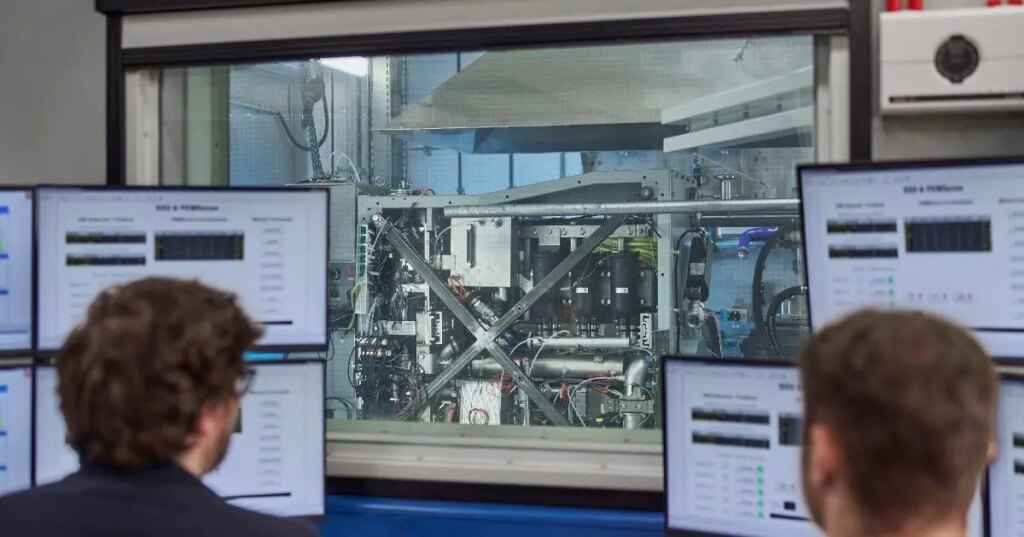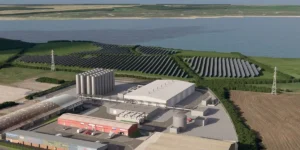3MW Of Clean Energy In A 40’ Container? Ricardo Just Made It Happen – Hydrogen Fuel News

Ricardo Achieves Milestone in Hydrogen Fuel Cell Innovation
Ricardo, a global leader in clean energy solutions, has reached a significant milestone in its development of a high-powered, multi-stack hydrogen fuel cell module. Originally developed as part of the Sustainable Hydrogen Powered Shipping (sHYpS) project to accelerate maritime decarbonization, the versatile fuel cell module demonstrates potential for a wide range of applications beyond its initial purpose.
This latest innovation aligns with increasing global demand for green energy solutions across industries, as organizations look for efficient, zero-emission alternatives to traditional carbon-intensive systems.
Key Advancements in Hydrogen Fuel Cell Technology
Ricardo’s hydrogen fuel cell module represents significant advancements in engineering and green technology. Key features include:
- High Power Output: Generates 375 kW of net electrical power with a compact, efficient design.
- World-Leading Power Density: Achieves 146 kWe/m³ and 4.0 kg/kWe—setting a global benchmark for power density in fuel cell systems.
- Modular, Scalable Design: Eight modules integrated into a 40’ container deliver 3MW of power for maritime use.
- Safe Marine Certification: Approved in Principle by Lloyd’s Register for use in ocean-going applications, ensuring safety and reliability for maritime deployment.
- Swappable Hydrogen Storage: Incorporates a novel liquid hydrogen storage solution adaptable for various vessel types, simplifying refueling and prolonging operational utility.
The high power output of 375 kW and industry-leading power density make it ideal for powering maritime vessels, including cargo ships and passenger ferries, where efficient energy use and zero emissions are critical for meeting regulatory standards.
The modular, scalable design, with eight integrated modules delivering up to 3MW of power, is perfectly suited for large, energy-intensive applications like ocean-going vessels or even stationary power generation in remote areas. Its approval by Lloyd’s Register underscores its safety and reliability for maritime deployment, offering ship operators a certified solution that ensures compliance while advancing decarbonization goals.
Furthermore, the swappable hydrogen storage capability simplifies logistics, as vessels can quickly refuel and extend range without extensive downtime. Beyond maritime use, these compact, high-density fuel cells can be adapted to industries like rail, off-highway, and stationary power, addressing the growing demand for sustainable, high-power systems in both transportation and industrial settings.
How the Technology Works
Hydrogen fuel cells essentially generate electricity through a chemical reaction. Here’s a simplified breakdown of how Ricardo’s system operates:
- Hydrogen Input: Liquid hydrogen is stored in the system’s tank, awaiting conversion.
- Electrochemical Reaction: Within the fuel cell module, hydrogen reacts with oxygen drawn from the air.
- Electricity Generation: This reaction produces electrical energy, which is directed to power motors or stored in batteries for later use.
- By-product: The only output of the process is water vapor, making it an entirely zero-emission system.
Ricardo’s design integrates cutting-edge components, including specialized stacks from EKPO, alongside customized anode, cathode, thermal, and electrical sub-systems. A balance-of-plant control system ensures optimized performance and precision control over operations.
Andy Ennever, Global Head of Fuel Cells at Ricardo commented “Fuel cells are simple in theory but optimizing power density, efficiency and durability whilst meeting safety requirements is a complex process.”
The construction of the entire module emphasizes compactness and scalability. By engineering a containerized fuel cell solution, Ricardo provides a plug-and-play alternative suited for industries requiring high-power output in space-efficient formats.
Why This Milestone Matters
This milestone signifies the growing readiness of hydrogen fuel cell technology to transition from concept to practical implementation across sectors. Here’s why this achievement is critical:
- Accelerating Decarbonization: Industries such as maritime, rail, and automotive face increasing pressure to cut greenhouse gas emissions. Ricardo’s fuel cell system provides a viable solution to replace diesel engines and internal combustion systems.
- Energy Transition Readiness: Hydrogen fuel cells promise energy solutions that are not only green but also scalable, meeting various demands from stationary power to high-performance vehicles.
- Global Sustainability Targets: The International Maritime Organisation (IMO) and other regulatory bodies are enforcing stricter emission reduction targets. Ricardo’s certified module supports compliance with these frameworks, helping industries meet sustainability requirements.
- Versatility Across Industries: While designed initially for the shipping sector, the module’s applications extend to rail, off-highway, stationary, and automotive industries, proving its adaptability.
Additionally, projects like sHYpS offer tangible evidence of international collaboration on hydrogen innovations, sparking greater investment and interest in the sector.
Harnessing the Technology Today and Tomorrow
The immediate applications of this technology are clear. For the maritime industry, Ricardo’s fuel cell module introduces a zero-emission option for powering vessels navigating international waters. Its adaptable design and liquid hydrogen storage solution simplify the adoption process, paving the way for widespread integration.
Beyond shipping, these compact, high-density modules can support stationary power generation for remote or off-grid locations, as well as rail and heavy-duty vehicles. The ability to containerize the system makes deployment to varied industrial settings swift and practical.
Looking to the future, as hydrogen production infrastructure grows, fuel cell systems could dominate in everything from urban transportation to large-scale energy storage grids. Early adoption of these systems will provide valuable operational insights, further optimizing their performance which should result in reduced costs over time.








